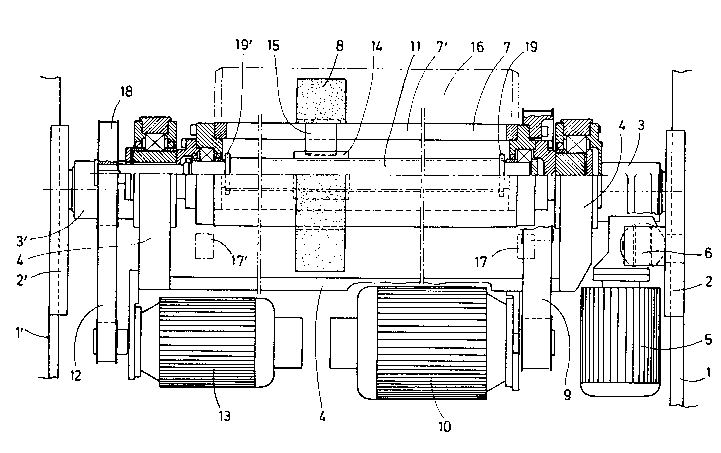Some of the information on this Web page has been provided by external sources. The Government of Canada is not responsible for the accuracy, reliability or currency of the information supplied by external sources. Users wishing to rely upon this information should consult directly with the source of the information. Content provided by external sources is not subject to official languages, privacy and accessibility requirements.
Any discrepancies in the text and image of the Claims and Abstract are due to differing posting times. Text of the Claims and Abstract are posted:
| (12) Patent Application: | (11) CA 2147920 |
|---|---|
| (54) English Title: | ROLL GRINDING MACHINE |
| (54) French Title: | MACHINE A RECTIFIER LES CYLINDRES DE LAMINOIRS |
| Status: | Deemed Abandoned and Beyond the Period of Reinstatement - Pending Response to Notice of Disregarded Communication |
| (51) International Patent Classification (IPC): |
|
|---|---|
| (72) Inventors : |
|
| (73) Owners : |
|
| (71) Applicants : |
|
| (74) Agent: | RICHES, MCKENZIE & HERBERT LLP |
| (74) Associate agent: | |
| (45) Issued: | |
| (22) Filed Date: | 1995-04-26 |
| (41) Open to Public Inspection: | 1995-10-29 |
| Examination requested: | 2002-04-09 |
| Availability of licence: | N/A |
| Dedicated to the Public: | N/A |
| (25) Language of filing: | English |
| Patent Cooperation Treaty (PCT): | No |
|---|
| (30) Application Priority Data: | ||||||
|---|---|---|---|---|---|---|
|
A grinding machine for the rolls of a roll stand includes a
guide unit extending parallel to the roll to be ground. Mounted
on the guide unit is a grinding unit which is displaceable in
longitudinal direction of the roll by a displacement drive. The
grinding unit is adjustable relative to the roll by adjusting
drives. The guide unit is provided with a rotary drive which is
capable of rotating the guide unit about its longitudinal axis.
The grinding unit is formed by a grinding element which is
symmetrical with respect to rotation. The grinding element is
connected to the guide unit in such a way that the grinding
element and the guide unit rotate together.
Note: Claims are shown in the official language in which they were submitted.
Note: Descriptions are shown in the official language in which they were submitted.

2024-08-01:As part of the Next Generation Patents (NGP) transition, the Canadian Patents Database (CPD) now contains a more detailed Event History, which replicates the Event Log of our new back-office solution.
Please note that "Inactive:" events refers to events no longer in use in our new back-office solution.
For a clearer understanding of the status of the application/patent presented on this page, the site Disclaimer , as well as the definitions for Patent , Event History , Maintenance Fee and Payment History should be consulted.
| Description | Date |
|---|---|
| Inactive: IPC from MCD | 2006-03-11 |
| Inactive: IPC from MCD | 2006-03-11 |
| Inactive: IPC from MCD | 2006-03-11 |
| Application Not Reinstated by Deadline | 2004-04-26 |
| Time Limit for Reversal Expired | 2004-04-26 |
| Deemed Abandoned - Failure to Respond to Maintenance Fee Notice | 2003-04-28 |
| Inactive: Application prosecuted on TS as of Log entry date | 2002-05-02 |
| Letter Sent | 2002-05-02 |
| Inactive: Status info is complete as of Log entry date | 2002-05-02 |
| Request for Examination Requirements Determined Compliant | 2002-04-09 |
| All Requirements for Examination Determined Compliant | 2002-04-09 |
| Letter Sent | 1998-06-17 |
| Reinstatement Requirements Deemed Compliant for All Abandonment Reasons | 1998-06-11 |
| Deemed Abandoned - Failure to Respond to Maintenance Fee Notice | 1998-04-27 |
| Letter Sent | 1997-07-02 |
| Reinstatement Requirements Deemed Compliant for All Abandonment Reasons | 1997-06-19 |
| Deemed Abandoned - Failure to Respond to Maintenance Fee Notice | 1997-04-28 |
| Inactive: Adhoc Request Documented | 1997-04-28 |
| Application Published (Open to Public Inspection) | 1995-10-29 |
| Abandonment Date | Reason | Reinstatement Date |
|---|---|---|
| 2003-04-28 | ||
| 1998-04-27 | ||
| 1997-04-28 |
The last payment was received on 2002-03-27
Note : If the full payment has not been received on or before the date indicated, a further fee may be required which may be one of the following
Please refer to the CIPO Patent Fees web page to see all current fee amounts.
| Fee Type | Anniversary Year | Due Date | Paid Date |
|---|---|---|---|
| Reinstatement | 1997-06-19 | ||
| MF (application, 2nd anniv.) - standard | 02 | 1997-04-28 | 1997-06-19 |
| MF (application, 3rd anniv.) - standard | 03 | 1998-04-27 | 1998-06-11 |
| Reinstatement | 1998-06-11 | ||
| MF (application, 4th anniv.) - standard | 04 | 1999-04-26 | 1999-03-23 |
| MF (application, 5th anniv.) - standard | 05 | 2000-04-26 | 2000-03-27 |
| MF (application, 6th anniv.) - standard | 06 | 2001-04-26 | 2001-03-22 |
| MF (application, 7th anniv.) - standard | 07 | 2002-04-26 | 2002-03-27 |
| Request for examination - standard | 2002-04-09 |
Note: Records showing the ownership history in alphabetical order.
| Current Owners on Record |
|---|
| SMS SCHLOEMANN-SIEMAG AKTIENGESELLSCHAFT |
| Past Owners on Record |
|---|
| DIETER ROSENTHAL |
| HANS-JURGEN BENDER |
| WOLFGANG ROHDE |